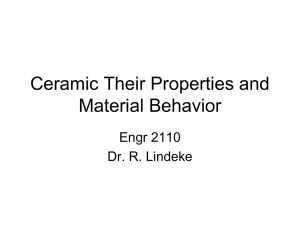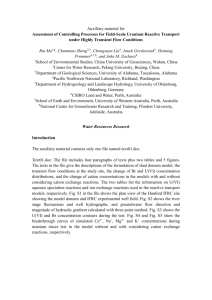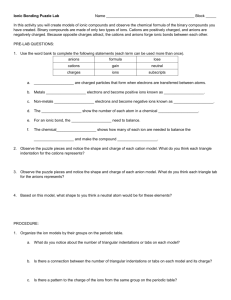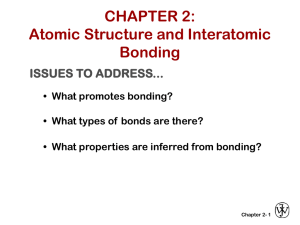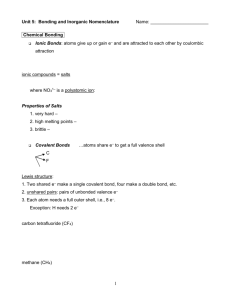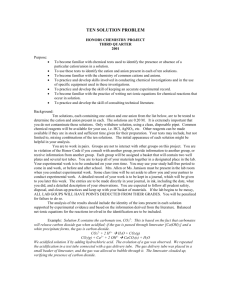Chapter 12: Structures & Properties of Ceramics
advertisement
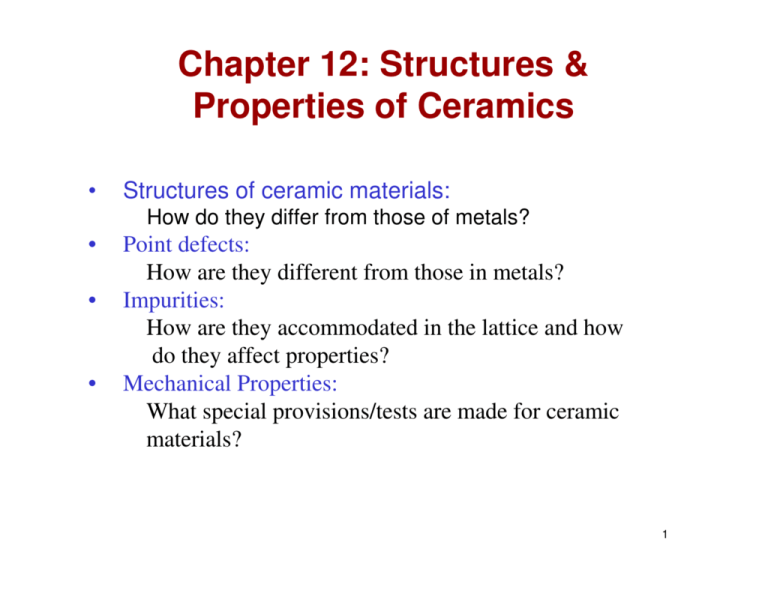
Chapter 12: Structures &
Properties of Ceramics
•
Structures of ceramic materials:
How do they differ from those of metals?
•
•
•
Point defects:
How are they different from those in metals?
Impurities:
How are they accommodated in the lattice and how
do they affect properties?
Mechanical Properties:
What special provisions/tests are made for ceramic
materials?
1
Ceramic Bonding
• Bonding:
-- Mostly ionic, some covalent.
-- % ionic character increases with difference in
electronegativity.
• Large vs small ionic bond character:
CaF2: large
SiC: small
Adapted from Fig. 2.7, Callister 7e.
2
Ionic Crystals
Note: larger anion radius
Cation Radius (nm)
0.100
0.072
0.102
0.053
0.040
Anion Radius (nm)
0.133
0.14
0.182
0.140
0.140
Most ionic crystals can be considered as close-packed structure of anions
with cations in the interstitial sites.
Cations: metallic ions, positively charged
Anions: nonmetallic ions, negatively charged
3
Ceramic Crystal Structures
Oxide structures
– oxygen anions much larger than metal cations
– close packed oxygen in a lattice (usually FCC)
– cations in the holes of the oxygen lattice
4
Site Selection
Which sites will cations occupy?
1. Size of sites
– does the cation fit in the site
2. Stoichiometry
– if all of one type of site is full, the
remainder have to go into other types of
sites.
3. Bond Hybridization
5
Ionic Bonding & Structure
1. Size - Stable structures:
--maximize the # of nearest oppositely charged neighbors.
-
+
-
-
-
unstable
• Charge Neutrality:
-
stable
--Net charge in the
structure should
be zero.
--General form:
+
-
CaF 2 :
-
Adapted from Fig. 12.1,
Callister 7e.
+
-
-
stable
Ca 2+ +
cation
Fanions
F-
A m Xp
m, p determined by charge neutrality
6
Coordination # and Ionic Radii
r cation
• Coordination # increases with r
anion
Issue: How many anions can you
arrange around a cation?
r cation
r anion
< 0.155
Coord
#
2
linear
0.155 - 0.225
3
triangular
0.225 - 0.414
4
TD
0.414 - 0.732
6
OH
0.732 - 1.0
8
cubic
Adapted from Table 12.2,
Callister 7e.
ZnS
(zincblende)
Adapted from Fig.
12.4, Callister 7e.
NaCl
(sodium
chloride)
Adapted from Fig.
12.2, Callister 7e.
CsCl
(cesium
chloride)
Adapted from Fig.
12.3, Callister 7e.
7
Cation-anion stable configuration
e.g. 3-coordinate
when
cos α =
rA
rA + rC
Rewrite as
1
rC
=
−1
rA cos α
With α = 30o
Minimum ratio for 3-coordinate
rC
= 0.155
rA
8
Cation Site Size
• Determine minimum rcation/ranion for OH site (C.N. = 6)
2ranion + 2rcation = 2a
a = 2ranion
2ranion + 2rcation = 2 2ranion
ranion + rcation = 2ranion
rcation = ( 2 −1)ranion
rcation
= 0.414
ranion
9
Site Selection II
2. Stoichiometry
– If all of one type of site is full, the remainder have
to go into other types of sites.
Ex: FCC unit cell has 4 OH and 8 TD sites.
If for a specific ceramic each unit cell has 6 cations
and the cations prefer OH sites
4 in OH
2 in TD
10
Interstitial sites in FCC
Octahedral (Oh) sites
1 at the center
Net 4 Oh sites/unit cell
12 middle of the
edge sites (each
shared by 4 unit
cells)
Tetrahedral (Td) sites
Net 8 Td sites/unit cell
11
Site Selection III
3. Bond Hybridization – significant covalent bonding
– the hybrid orbitals can have impact if significant
covalent bond character present
– For example in SiC
•
XSi = 1.8 and XC = 2.5
% ionic character = 100 {1 - exp[-0.25( X Si − X C )2 ]} = 11.5%
• ca. 89% covalent bonding
• both Si and C prefer sp3 hybridization
• Therefore in SiC get TD sites
12
Example: Predicting Structure of FeO
• On the basis of ionic radii, what crystal structure
would you predict for FeO?
Cation Ionic radius (nm)
Al 3+
0.053
Fe 2+
0.077
Fe 3+
0.069
Ca 2+
0.100
Anion
O2Cl F-
• Answer:
rcation 0.077
=
ranion 0.140
= 0.550
based on this ratio,
--coord # = 6
--structure = NaCl
0.140
0.181
0.133
Data from Table 12.3,
Callister 7e.
13
Rock Salt Structure
Same concepts can be applied to ionic solids in general.
Example: NaCl (rock salt) structure
rNa = 0.102 nm
rCl = 0.181 nm
rNa/rCl = 0.564
∴ cations prefer OH sites
Adapted from Fig.
12.2, Callister 7e.
14
MgO and FeO
MgO and FeO also have the NaCl structure
O2-
rO = 0.140 nm
Mg2+
rMg = 0.072 nm
rMg/rO = 0.514
∴ cations prefer OH sites
Adapted from Fig.
12.2, Callister 7e.
So each oxygen has 6 neighboring Mg2+
15
AX Crystal Structures
AX–Type Crystal Structures include NaCl, CsCl, and zinc blende
Cesium Chloride structure:
rCs +
rCl−
=
0.170
= 0.939
0.181
∴ cubic sites preferred
So each Cs+ has 8 neighboring ClAdapted from Fig.
12.3, Callister 7e.
16
AX Crystal Structures
Zinc Blende structure
rZn2+
rO 2−
=
0.074
= 0.529 ⇒ OH ??
0.140
• Size arguments predict Zn2+
in OH sites,
• In observed structure Zn2+
in TD sites
• Why is Zn2+ in TD sites?
– bonding hybridization of
zinc favors TD sites
Adapted from Fig.
12.4, Callister 7e.
So each Zn2+ has 4 neighboring O2-
Ex: ZnO, ZnS, SiC
17
AX2 Crystal Structures
Fluorite structure
• Calcium Fluorite (CaF2)
• cations in cubic sites
• UO2, ThO2, ZrO2, CeO2
• antifluorite structure –
cations and anions
reversed
Adapted from Fig.
12.5, Callister 7e.
18
ABX3 Crystal Structures
• Perovskite
Ex: complex oxide
BaTiO3
Adapted from Fig.
12.6, Callister 7e.
19
Mechanical Properties
We know that ceramics are more brittle than
metals. Why?
• Consider method of deformation
– slippage along slip planes
• in ionic solids this slippage is very difficult
• too much energy needed to move one anion past
another anion
20
Ceramic Density Computation
Number of formula units/unit cell
n′( ΣAC + ΣAA )
ρ=
VC N A
Volume of unit cell
n’ = number of cations in unit cell
AC = atomic weight of cation
nA = number of anions in unit cell
AA = atomic weight of anion
VC = volume of unit cell
NA = Avogadro’s number
21
Theoretical Density Calculation of NaCl
n′( ΣAC + ΣAA )
ρ=
VC N A
ANa = 22.99 g/mol
ACl = 35.45 g/mol
a=2(rNa++rCl-)
a = 2(rNa++rCl-) = 2(0.102+0.181) nm
Thus, Vc = a3 = (2rNa++2rCl-)3
And n’ is 4 pair of Na and Cl in one unit cell,
finally,
ρ=
Cl-
n' ( ANa + ACl )
= 2.14 g / cm 3
3
(2rNa + + 2rCl − ) N A
Na+
22
Silicate Ceramics
Most common elements on earth are Si & O
Si4+
O2Adapted from Figs.
12.9-10, Callister 7e.
crystobalite
• SiO2 (silica) structures are quartz, crystobalite, &
tridymite
• The strong Si-O bond leads to a strong, high melting
material (1710ºC)
23
Amorphous Silica
• Silica gels - amorphous SiO2
– Si4+ and O2- not in well-ordered
lattice
– Charge balanced by H+ (to form
OH-) at “dangling” bonds
• very high surface area > 200 m2/g
– SiO2 is quite stable, therefore
unreactive
• makes good catalyst support
Adapted from Fig.
12.11, Callister 7e.
24
Silica Glass
• Dense form of amorphous silica
– Charge imbalance corrected with “counter
cations” such as Na+
– Borosilicate glass is the pyrex glass used
in labs
• better temperature stability & less brittle than sodium
glass
25
Silicates
– Combine SiO44- tetrahedra by having them share
corners, edges, or faces
Adapted from Fig.
12.12, Callister 7e.
Mg2SiO4
Ca2MgSi2O7
– Cations such as Ca2+, Mg2+, & Al3+ act to
neutralize & provide ionic bonding
26
Layered Silicates
• Layered silicates (clay silicates)
– SiO4 tetrahedra connected
together to form 2-D plane
• (Si2O5)2• So need cations to balance charge
=
Adapted from Fig.
12.13, Callister 7e.
27
Layered Silicates
• Kaolinite clay alternates (Si2O5)2- layer with Al2(OH)42+
layer
Adapted from Fig.
12.14, Callister 7e.
Note: these sheets loosely bound by van der Waal’s forces
28
Layered Silicates
• Can change the counterions
– this changes layer spacing
– the layers also allow absorption of water
• Micas KAl3Si3O10(OH)2
– smooth surface for AFM sample holder
• Bentonite
– used to seal wells
– packaged dry
– swells 2-3 fold in H2O
– pump in to seal up well so no polluted ground
water seeps in to contaminate the water supply.
29
Carbon Forms
• Carbon black – amorphous –
surface area ca. 1000 m2/g
• Diamond
– tetrahedral carbon
• hard – no good slip planes
• brittle – can cut it
– large diamonds – jewelry
– small diamonds
• often man made - used for
cutting tools and polishing
– diamond films
Adapted from Fig.
12.15, Callister 7e.
• hard surface coat – tools,
medical devices, etc.
30
Carbon Forms - Graphite
• layer structure – aromatic layers
Adapted from Fig.
12.17, Callister 7e.
– weak van der Waal’s forces between layers
– planes slide easily, good lubricant
31
Carbon Forms - Graphite
32
Carbon Forms –
Fullerenes and Nanotubes
• Fullerenes or carbon nanotubes
– wrap the graphite sheet by curving into ball or tube
– Buckminister fullerenes
• Like a soccer ball C60 - also C70 + others
Adapted from Figs.
12.18 & 12.19,
Callister 7e.
33
Diamond-like Carbon Film
• Ultralow friction surface
• http://en.wikipedia.org/wiki/Diamondlike_carbon
34
Defects in Ceramic Structures
• Frenkel Defect
--a cation is out of place.
• Shottky Defect
--a paired set of cation and anion vacancies.
Shottky
Defect:
Adapted from Fig. 12.21, Callister
7e. (Fig. 12.21 is from W.G.
Moffatt, G.W. Pearsall, and J.
Wulff, The Structure and
Properties of Materials, Vol. 1,
Structure, John Wiley and Sons,
Inc., p. 78.)
Frenkel
Defect
• Equilibrium concentration of defects
~e
−QD / kT
35
Impurities
• Impurities must also satisfy charge balance = Electroneutrality
• Ex: NaCl
Na +
Cl -
• Substitutional cation impurity
cation
vacancy
Ca 2+
Na +
Na +
initial geometry
Ca 2+ impurity
• Substitutional anion impurity
O2-
initial geometry
Cl Cl O2- impurity
Ca 2+
resulting geometry
anion vacancy
resulting geometry
36
Ceramic Phase Diagrams
°
For the MgO/Al2O3 phase diagram, what are the:
a) Composition of the MgO (ss) phase for a 40 wt% Al2O3 alloy at 1800°C?
b) Chemical formula of the interceramic compound?
c) Composition of the eutectic alloy with the lowest MgO composition?
d) Primary phase for a 30 wt% Al2O3 alloy cooled from the liquid phase to
room temperature?
e) Solubility of Al2O3 in MgO at 1900°C?
37
a) Composition of the MgO(ss) phase:
MgO: 92-93 wt% , Al2O3: 7-8 wt%
b) Chemical formula of the interceramic compound:
MgAl2O4
c) Composition of the eutectic alloy with the lowest
MgO composition:
MgO: 6-7 wt% , Al2O3: 93-94 wt%
d) Primary phase for a 30 wt% Al2O3 alloy cooled
from the liquid phase to room temperature:
MgO(ss)
e) Solubility of Al2O3 in MgO at 1900°C:
12-13 wt%
38
Measuring Elastic Modulus
• Room T behavior is usually elastic, with brittle failure.
• 3-Point Bend Testing often used.
--tensile tests are difficult for brittle materials (ε<0.1%).
F
cross section
L/2
d
b
rect.
Adapted from Fig. 12.32,
Callister 7e.
L/2
R
d = midpoint
deflection
circ.
• Determine elastic modulus according to:
F
E=
x
slope =
F
L3
F
δ 4bd 3
δ
rect.
cross
section
δ
linear-elastic behavior
=
F
L3
δ 12 π R4
circ.
cross
section
39
Measuring Strength
• 3-point bend test to measure room T strength.
cross section
d
b
rect.
L/2
F
L/2
Adapted from Fig. 12.32,
Callister 7e.
R
d = midpoint
deflection
circ.
location of max tension
• Typ. values:
• Flexural strength:
σ fs =
Ff
F
1.5Ff L
bd 2
rect.
x
=
Ff L
πR3
σfs (MPa) E(GPa)
Si nitride
250-1000 304
Si carbide
100-820 345
Al oxide
275-700 393
glass (soda)
69
69
Material
Data from Table 12.5, Callister 7e.
δfs
δ
40
Measuring Elevated T Response
• Elevated Temperature Tensile Test (T > 0.4 Tm).
creep test
σ
ε
x
.
slope = εss = steady-state creep rate
σ
time
41
Summary
• Ceramic materials have covalent & ionic bonding.
• Structures are based on:
•
•
•
•
-- charge neutrality
-- maximizing # of nearest oppositely charged neighbors.
Structures may be predicted based on:
-- ratio of the cation and anion radii.
Defects
-- must preserve charge neutrality
-- have a concentration that varies exponentially w/T.
Room T mechanical response is elastic, but fracture
is brittle, with negligible deformation.
Elevated T creep properties are generally superior to
those of metals (and polymers).
42

